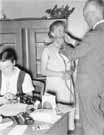
|
|
|

|

|

|

|
|
Click on an image to see a larger, more detailed picture.
|
|
|
|
|
| 1935: Steps Toward Destruction |

|
pg. 93 |

|
|
|
|
| |
 Wilhelm Frick began his career on Munich's police force, a job he lost because of his support for Hitler's failed coup in November 1923. In 1924 he was elected to the Reichstag, becoming leader of the Nazi delegation in 1928. As Thuringia's minister of the interior (1930-1931), he nazified the state's police force, which became notorious for its brutal antisemitism. Frick coauthored the infamous Nuremberg Laws (1935) and, as Germany's minister of the interior, oversaw their enforcement. His political career had, however, reached its zenith, and he played only a small role in the final years of the Third Reich.
Wilhelm Frick began his career on Munich's police force, a job he lost because of his support for Hitler's failed coup in November 1923. In 1924 he was elected to the Reichstag, becoming leader of the Nazi delegation in 1928. As Thuringia's minister of the interior (1930-1931), he nazified the state's police force, which became notorious for its brutal antisemitism. Frick coauthored the infamous Nuremberg Laws (1935) and, as Germany's minister of the interior, oversaw their enforcement. His political career had, however, reached its zenith, and he played only a small role in the final years of the Third Reich.
Photo: William O. McWorkman/United States Holocaust Memorial Museum Photo Archive
|
 This illustration from a filmstrip produced by the Reich Propaganda Office demonstrates that for the 5.50 Reichsmarks it costs to feed, house, and clothe one disabled person for a single day, an entire healthy German family could survive. Propaganda such as this helped prepare the German people for the murder of those deemed genetically inferior.
This illustration from a filmstrip produced by the Reich Propaganda Office demonstrates that for the 5.50 Reichsmarks it costs to feed, house, and clothe one disabled person for a single day, an entire healthy German family could survive. Propaganda such as this helped prepare the German people for the murder of those deemed genetically inferior.
Photo: Roland Klemig/United States Holocaust Memorial Museum Photo Archive
|
 "Original Sin"
"Original Sin"
In 1924 Adolf Hitler warned that "blood desecration" (Blutschande) and "defilement of the race" (Rassenschande) were the "original sin." His book Mein Kampf condemns the deleterious effects of "racial cross-breeding." The laws of nature, Hitler said, dictated that "every animal mates only with a member of the same species....The titmouse seeks the titmouse, the wolf the she-wolf, etc." Since the bedrock of Hitler's race theory was his belief in the biological superiority of the Aryan race, he vowed to end what he believed to be the harmful contamination of Aryan blood and maintain its purity. For Hitler, the worst violation of blood occurred in the mating between Jews and Aryans. The 1935 "Law for the Protection of German Blood" made sexual intercourse between Aryan and non-Aryan a crime. By 1945 race defilement was punishable by execution.
Photo: Hoover Institution/United States Holocaust Memorial Museum Photo Archive
|
|

|

|

|

|
 September 15, 1935: The first Nuremberg Laws are passed, including the Reich Citizenship Law and the Law for Protection of German Blood and Honor. The Jews are returned to the legal position they had occupied in Germany before their emancipation in the 19th century. Jews can no longer exist as German citizens or marry non-Jews.
September 15, 1935: The first Nuremberg Laws are passed, including the Reich Citizenship Law and the Law for Protection of German Blood and Honor. The Jews are returned to the legal position they had occupied in Germany before their emancipation in the 19th century. Jews can no longer exist as German citizens or marry non-Jews.
|
 September 15, 1935: Another new Nuremberg Law, the Reich Flag Law, defines the official flag of Germany: a black swastika in a white circle on a red field.
September 15, 1935: Another new Nuremberg Law, the Reich Flag Law, defines the official flag of Germany: a black swastika in a white circle on a red field.
|
 September 15, 1935: The 1935 National Socialist Party rally marks the first display of the product of Germany's illegal rearmament.
September 15, 1935: The 1935 National Socialist Party rally marks the first display of the product of Germany's illegal rearmament.
|
 October 18, 1935: The German government introduces the antisemitic Law for the Protection of the Hereditary Health of the German People.
October 18, 1935: The German government introduces the antisemitic Law for the Protection of the Hereditary Health of the German People.
|
 November 1, 1935: An addition to the Reich Citizenship Law disqualifies Jews from German citizenship.
November 1, 1935: An addition to the Reich Citizenship Law disqualifies Jews from German citizenship.
|
 November 14, 1935: The National Law of Citizenship is instituted throughout Germany, establishing for the first time official definitions of "Jew" (anyone who has two Jewish grandparents and is a member of the Jewish religious community, and anyone with three or more Jewish grandparents) and "Mischlinge" (mixed race; that is, part Jew). Anywhere from 250,000 to 500,000 German citizens fall into the Mischlinge category. Marriages between Jews and second-generation Mischlinge are prohibited.
November 14, 1935: The National Law of Citizenship is instituted throughout Germany, establishing for the first time official definitions of "Jew" (anyone who has two Jewish grandparents and is a member of the Jewish religious community, and anyone with three or more Jewish grandparents) and "Mischlinge" (mixed race; that is, part Jew). Anywhere from 250,000 to 500,000 German citizens fall into the Mischlinge category. Marriages between Jews and second-generation Mischlinge are prohibited.
|
|
|
|
|
| 1935: Steps Toward Destruction |

|
pg. 93 |

|
|
The Holocaust Chronicle
© 2009 Publications International, Ltd.
|
|
